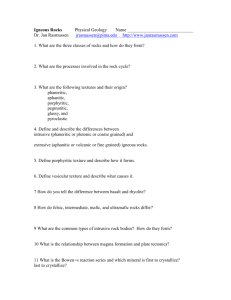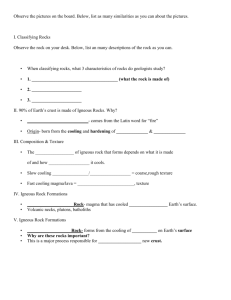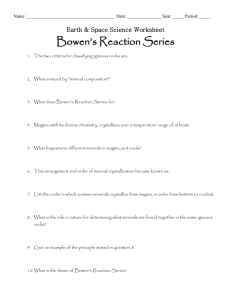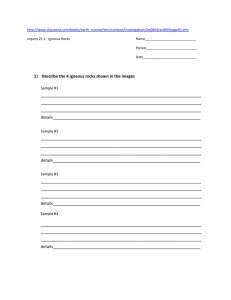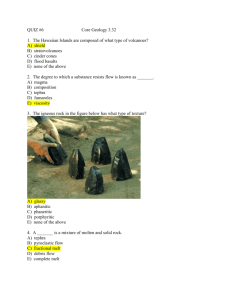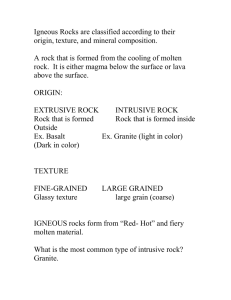Igneous Rocks
advertisement
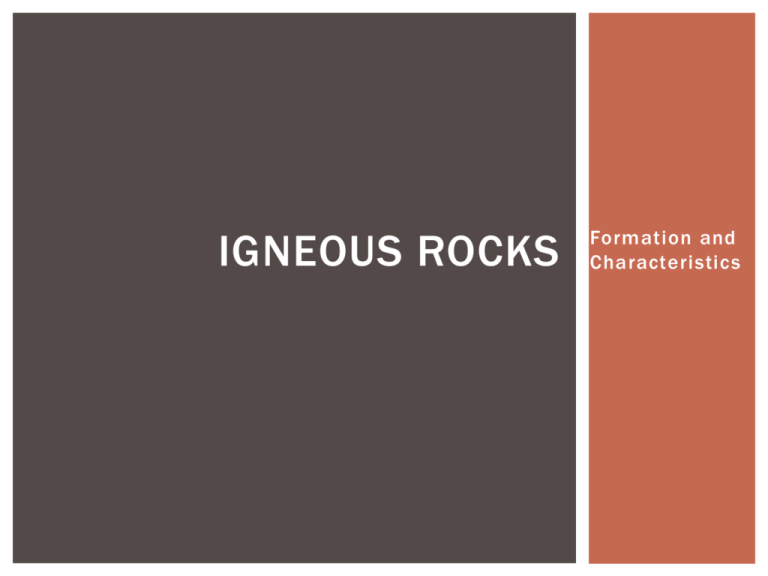
IGNEOUS ROCKS Formation and Characteristics IGNEOUS ROCKS Igneous rocks are formed from the crystallization of magma. Molten rock can occur in three dif ferent ways: Magma: molten rock below Earth’s surface Lava: magma on the Earth’s surface Pyroclastic material: (pyro=fire, clastic=debris) Airborne lava that cools at it falls. MAGMA When we talked about Earth’s crust we said that the most common elements were: Oxygen Silicon Aluminum Iron Magnesium Calcium Potassium Sodium We said that the crust was mostly Silicate (SiO 2 ) rocks, magma is classified by its Silica content. MAGMA Mafic magma (Basaltic) Thin and runny LOW silica content (<50%) LOW gas content HIGH in Ca, Fe, and Mg Intermediate magma (Andesitic) Medium Consistancy MODERATE silica content (~60%) MODERATE gas content MODERATE amount of all crustal elements MAGMA Felsic magma (Rhyolitic) Thick and blocky HIGH silica content HIGH gas content LOW in Ca, Fe, and Mg HIGH in K and Al VISCOSIT Y OF MAGMA/ LAVA Viscosity: the resistance of a liquid to flow. Very important for volcanic activity MAFIC- low silica, low viscosity, runny, less violent eruptions FELSIC- high silica, high viscosity, thick, more violent eruptions IGNEOUS ROCK COMPOSITION 98.5% of earths crust is made of only 8 elements! Oxygen and Silicon make up 75% Aluminum=8.1% Iron=5% Calcium=3.6% Sodium=2.8% Potassium=2.6% Magnesium=2.1% Sooooooo, the type of rock created is mainly determined by: What elements are present during cooling How rapidly does the rock cool Neatly, illustrated by Bowen’s reaction series. BOWEN’S REACTION SERIES IGNEOUS TEXTURES Igneous rocks are classified in two ways Texture Composition Textures (How big are the mineral grains) Phaneritic: can be seen with naked eye different colored and interlocking shapes Aphanitic: mineral grains too small to be seen, microscopic Porphyritic: two distinct sizes of mineral PHANERITIC TEXTURE Intrusive rock Cooled beneath Earth’s surface Cooled very slowly Higher temperature and pressure APHANITIC TEXTURE Extrusive Igneous Rock Cooled on Earth’s surface Cooled relatively fast Lower temperature and pressure PORPHYRITIC TEXTURE Complex cooling Partially cools below and above Earth’s surface Distinct crystal sizes COMPOSITION Igneous rocks are named by texture and mineral composition SUMMARY Magmas have three main types Mafic Intermediate Felsic Composition and cooling rate determine what minerals will form Three types of igneous textures Phaneritic Texture Aphanitic Texture Porphyritic Texture Put it all together and you can identify your igneous rock
